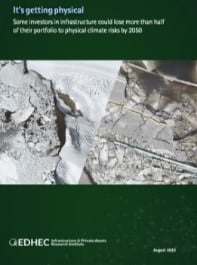
Advancing Infrastructure Research: Salient Publications of EDHECInfra & Private Assets
In 2021, EDHECinfra & Private Assets launched an ambitious $10M investment project to create scientific climate and social risk and impact metrics for infrastructure investors. Leveraging six years of experience collecting financial data and creating internationally recognised benchmarks for infrastructure investors, the research center is producing a body of research and investment knowledge on sustainability and infrastructure investment.
In this article we delve into some of the key research endeavors undertaken by EDHECInfra & Private Assets on the nuanced landscape of infrastructure investments, climate risks, and financial performance:
-54%
Research Paper: It’s getting physical - Some investors in infrastructure could lose more than half of their portfolio to physical climate risks by 2050

This research note shows that the physical risks created by climate change are not limited to a distant future for investors in infrastructure, some of whom could well lose more than 50% of the value of their portfolio to physical climate risk before 2050 in the event of runaway climate change. Moreover, the average investor will also lose twice as much to extreme weather, mostly in OECD countries, compared to a low carbon scenario.
Access the replay of the webinar
Is there a carbon factor in infrastructure returns?
Research Paper: Carbon Footprints and Financial Performance of Transport Infrastructures: the Case of Airports

Investors in infrastructure and regulators require better data to understand the implications of climate risks for assets that are highly connected to climate change. Carbon emissions and the so-called "transition risks" they create is a concern from an investment standpoint. In this paper, we develop a methodology to estimate the carbon footprint of thousands of airport infrastructures around the world and test for the existence of a relationship between carbon emissions and realised or expected returns in the private airport investment sector.
Are physical climate risks priced-in today?
Research Paper: Physical Risks & the Cost of Capital of Infrastructure Investments

Despite the pressing need for asset-level physical risk data, infrastructure investors currently have very limited access to this type of information at the asset level, let alone the ability to conduct a systematic assessment of the financial implications of physical climate hazards. In this paper, we developed a methodology to calculate the potential damage associated with different types of physical risks at the asset level, and conduct a practical implementation for flood damages in the airport sector in the United States. We then used these results to analyse the relationship between airports' capital costs and exposure to physical climate risk.
The pricing of green infrastructure
Research Paper: The realised and expected financial performance of green power infrastructure investment, 2010-2021

Should investors expect to earn higher returns on greener and more sustainable investments? In 2011, green power projects had expected returns of 8% and brown power projects 9%. Their 10-year annualised total returns in 2021 were 16% and 17% respectively. These two figures may seem related but correspond in fact to very different economic fundamentals. In this paper, we reviewed the empirical evidence of historical outperformance of green infrastructure investments and considered whether this finding implies continued future outperformance.
Read the article Is there a ‘green’ risk factor in infrastructure investment? that appeared in the EDHEC Climate+Finance supplement to Investment & Pensions Europe and Pensions & Investments.
Read the article Investments in green energy infrastructure: an (over)performance that will last? published in The Conversation. Article republished on EDHECVox, the EDHEC platform dedicated to scientific dissemination.
Does the rise of renewable energy create new risks for investors?
Research Paper: Insights from 20 years of energy transition in the UK

As green power sources that are intermittent become central to a power system, without commercially viable medium- and long-term storage options, what is the likely impact on the electricity market and system as a whole and do wind and solar investments, which have historically benefited from a safer, privileged position in the power sector, become riskier? We use the case of the UK as an example of an economy that has made a rapid transition to renewables and away from coal, while relying on very limited hydro and nuclear capacity i.e., the typical transition required of most advanced economies.
Read the article The rise of renewables is not without risk for investors published in The Conversation. Article republished on EDHECVox, the EDHEC platform dedicated to scientific dissemination.
EDHECInfra's research provides invaluable insights into the complex interplay between infrastructure investments, climate risks, and financial performance. Since its creation, EDHEC Infrastructure and Private Assets Institute has published more than 50 academic research papers.
Access all white papers and reports published by the Institute.

